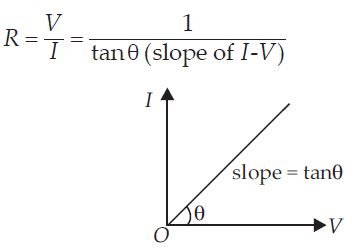Comprehensive Guide to Current Electricity for Class 12 Physics
Current electricity is the flow of electric charge through a conductor or circuit. It plays a central role in powering our modern world, from lighting and heating to complex electronic devices. Here's a structured overview of key concepts and principles in current electricity:
Current Electricity: It is defined as the rate of flow of electric charge through a cross-section of the conductor.
I = dq/dt
If the current is steady i.e. it does not change with time, then where q is the charge that flows across the cross-sectional area in time t.
The current is a scalar quantity. It is not a vector quantity as it does not follow the laws of vector addition.
Conventionally, the direction of the current is taken to be the direction of the flow of positive charges. Since electrons are negatively charged, hence their direction will be opposite to that of the conventional current flow.
The current is the same for all cross-section of a conductor of the non-uniform cross-section.
Current in different situations is due to the motion of different charge carriers.
– Current in conductors and vacuum tubes is due to the motion of electrons.
– In electrolytes due to the motion of both positive and negative ions.
– In semiconductors due to the motion of electrons and holes.
– In the discharge tube (containing atomic gases) due to the motion of positive ions and negative electrons.
Current density: Current density at a point inside the conductor is defined as the amount of current flowing per unit area around that point of the conductor, provided the area is held in a direction normal to the current. It is denoted by symbol j.
J = I/A
Ohm’s law: It states that the current (I) flowing through a conductor is directly proportional to the potential difference (V) across the ends of the conductor, provided physical conditions of the conductor such as temperature, mechanical strain, etc. are kept constant.
V ∞ I or V = RI
Where the constant of proportionality R is called resistance of the conductor.
The graph between the potential difference (V) and current (I) through a metallic conductor is a straight line passing through the origin as shown in the figure.
1. Fundamentals of Electric Current
- Definition of Current:
- Electric current is the rate of flow of electric charge, measured in amperes (A). Mathematically, it's defined as , where is charge and is time.
- Conventional Current vs. Electron Flow:
- Conventional current flows from positive to negative, while electrons, which are negatively charged, flow from negative to positive.
2. Voltage and Potential Difference
- Voltage (Potential Difference):
- Voltage, measured in volts (V), is the energy per unit charge provided by a source like a battery or generator. It's the driving force that pushes electric charges through a circuit.
- Sources of Voltage:
- Batteries and generators are common sources of voltage. Batteries provide energy through chemical reactions, while generators convert mechanical energy to electrical energy.
3. Resistance and Ohm's Law
- Resistance:
- Resistance, measured in ohms (Ω), opposes the flow of electric current. It depends on factors like material, length, cross-sectional area, and temperature.
- Ohm's Law:
- Ohm's Law relates voltage, current, and resistance in a linear relationship: . It states that current is directly proportional to voltage and inversely proportional to resistance.
Ohm’s law: It states that the current (I) flowing through a conductor is directly proportional to the potential difference (V) across the ends of the conductor, provided physical conditions of the conductor such as temperature, mechanical strain, etc. are kept constant.
V ∞ I or V = RI
Where the constant of proportionality R is called resistance of the conductor.
The graph between the potential difference (V) and current (I) through a metallic conductor is a straight line passing through the origin as shown in the figure.

4. Electrical Power and Energy
- Electrical Power:
- Power, measured in watts (W), is the rate at which electrical energy is used or converted into other forms of energy. It is given by , where is power, is current, and is voltage.
- Energy Consumption:
- Electrical energy is typically measured in watt-hours (Wh) or kilowatt-hours (kWh). This measures the total energy used over time and is crucial for understanding electricity bills.
5. Circuit Components and Configurations
- Series and Parallel Circuits:
- In a series circuit, components are connected end-to-end, so the same current flows through each component. In a parallel circuit, components are connected across common points, so the voltage across each component is the same.
- Resistors, Capacitors, and Inductors:
- Resistors oppose current flow, capacitors store electric charge, and inductors store energy in magnetic fields. These components are used in various combinations to build circuits.
6. Kirchhoff's Laws and Complex Circuits
- Kirchhoff's Current Law (KCL):
- KCL states that the total current entering a junction must equal the total current leaving the junction.
- Kirchhoff's Voltage Law (KVL):
- KVL states that the sum of all voltage drops around a closed loop must be zero. This helps in analyzing complex circuits with multiple loops.
7. Safety and Grounding
- Electrical Safety:
- Safety measures are crucial when dealing with electricity. Grounding, circuit breakers, and fuses are designed to prevent electrical shocks and fires.
- Grounding:
- Grounding provides a safe path for electric current in case of a fault. It connects electrical systems to the earth, ensuring excess current is safely discharged.
8. Applications and Technologies
- Electronics and Digital Devices:
- Current electricity powers a wide range of devices, from simple light bulbs to complex computers and smartphones.
- Renewable Energy and Power Grids:
- Understanding current electricity is essential for developing renewable energy sources like solar and wind, as well as for maintaining stable power grids.
If you'd like to discuss any of these topics in more detail, or if you have other questions about current electricity, I'm here to help.
The reciprocal of slope of the line gives resistance.
Ohmic and non-ohmic conductors
Ohmic conductors: Those conductors which obey Ohm’s law are known as ohmic conductors,
e.g. metals. For ohmic conductors, the graph between current and potential difference is a straight line passing through the origin.
Non-ohmic conductors: Those conductors which do not obey Ohm’s law are known as non-ohmic conductors e.g. diode valve, junction diode.
Electrochemical cell: It is a device which, converts chemical energy into electrical energy, maintains the flow of charge in a circuit.
Electromotive force (emf) of a cell
– It is defined as the potential difference between the two terminals of a cell in an open circuit i.e. when no current flows through the cell. It is denoted by symbol ℰ.
– The SI unit of emf is joule/coulomb or volt and its dimensional formula is [ML2T–3A–1].
– The emf of a cell depends upon the nature of electrodes, nature and the concentration of electrolyte used in the cell and its temperature.
Terminal potential difference: It is defined as the potential difference between two terminals of a cell in a closed circuit i.e., when current is flowing through the cell.
The internal resistance of a cell
– It is defined as the resistance offered by the electrolyte and electrodes of a cell when the current flows through it.
– The internal resistance of a cell depends upon the following factors:
Distance between the electrodes
The nature of the electrolyte
The nature of electrodes
Area of the electrodes, immersed in the electrolyte.
1. Electric Current
- Definition: Electric current is the flow of electric charge through a conductor, typically due to a potential difference (voltage).
- Formula: , where:
- is the current in amperes (A),
- is the electric charge in coulombs (C),
- is time in seconds (s).
2. Voltage (Potential Difference)
- Definition: Voltage, also known as potential difference, is the energy per unit charge that drives electric current through a circuit.
- Formula: , where:
- is the voltage in volts (V),
- is the work done or energy in joules (J),
- is the charge in coulombs (C).
3. Resistance
- Definition: Resistance is a measure of how much a conductor opposes the flow of electric current.
- Formula: , where:
- is the resistance in ohms (Ω),
- is the voltage in volts (V),
- is the current in amperes (A).
- Factors Affecting Resistance: Resistance depends on the conductor's material, length, cross-sectional area, and temperature. For a uniform cylindrical conductor:
- , where:
- is the resistivity of the material,
- is the length of the conductor,
- is the cross-sectional area.
- , where:
4. Ohm's Law
- Definition: Ohm's Law states that the current through a conductor between two points is directly proportional to the voltage across the two points and inversely proportional to the resistance.
- Formula: .
5. Power
- Definition: Power in an electric circuit is the rate at which electrical energy is converted into other forms of energy.
- Formula: , where:
- is power in watts (W),
- is the current in amperes (A),
- is the voltage in volts (V).
- Alternative Formulas: Based on Ohm's Law, you can also derive:
- ,
- .
6. Kirchhoff's Laws
- Kirchhoff's Current Law (KCL): The total current entering a junction must equal the total current leaving the junction.
- Kirchhoff's Voltage Law (KVL): The sum of all voltage drops in a closed loop must be zero.
7. Electrical Energy
- Definition: Electrical energy is the total energy used over time.
- Formula: , where:
- is energy in joules (J) or watt-hours (Wh),
- is power in watts (W),
- is current in amperes (A),
- is voltage in volts (V),
- is time in seconds (s) or hours (h).
